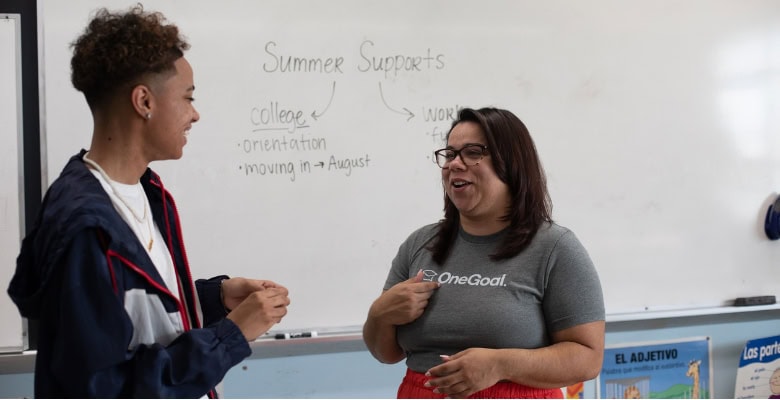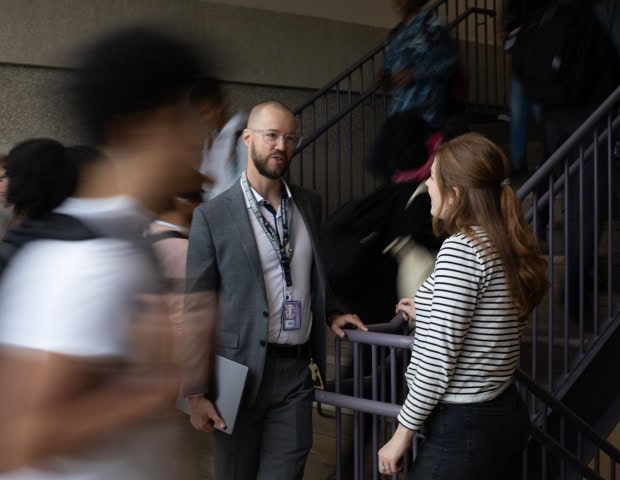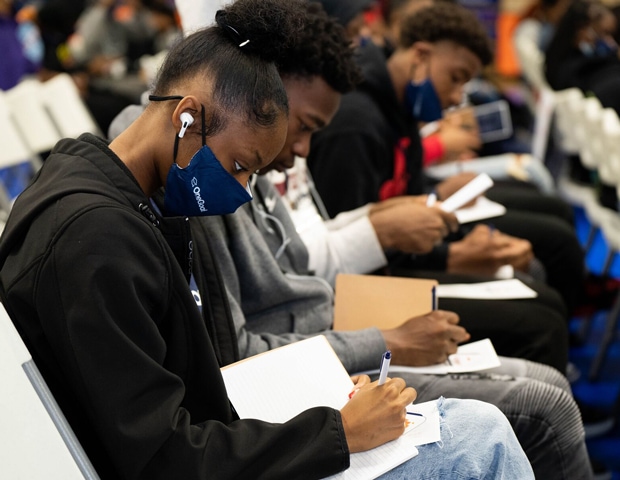College and career readiness is a frequently used metric in schools and in the postsecondary access field. But how is readiness defined? And what steps can schools take to help pave the way?
Preventing Summer Melt
By Monica Selagea
July 16, 2024
Ensuring Students Transition to College
Discover essential strategies and resources to help students overcome summer melt and successfully transition from high school to college. Learn how educators, parents, and colleges can work together to support at-risk students and ensure they stay on track for higher education.
The end of the school year is a time for celebrating graduations. Many educators, counselors, staff, and parents will applaud a student’s success and look forward to a break in the summer before sending their child into the next phase of their life. However, this hiatus does not last long as we need to ensure that during this break, we provide the proper support and guidance so that students smoothly and successfully matriculate from high school to college.

What is Summer Melt?
Summer melt is when high school graduates, who have been accepted into and plan to attend college, fail to do so. There are many factors that prevent students from realizing their goal of college enrollment, including the endless list of enrollment items and difficult financial considerations. A lack of funding to support educational aspirations and the failure to adhere to administrative deadlines are two of many hurdles that students face.
According to a Harvard University study, an estimated 10-40% of high school students with the intention to enroll in college never actually do so. Summer melt is a prevalent issue for education leaders. Students are failing to bridge that gap between institutions, but research has identified interventions that can have a significant impact on alleviating the summer melt phenomenon to increase college enrollment rates. It is not a question of whether the student wants to attend college or not, but if they have the guidance and resources they need when they are faced with barriers. So, how can educators, schools, programs, and parents help students who are at risk of summer melt? In order to help, we first need to understand the reasons why students experience summer melt.
Reasons Students Experience Summer Melt
This summer is unique, presenting more challenges than other years. Aside from institutional barriers and personal hurdles, financial aid is a major factor for summer melt. The rollout of the new FAFSA this year led to significant delays in filing, with submission rates lagging 20-30% behind prior years according to the National College Attainment Network. Understanding the reasons can lead us to find ways to help at-risk students.

Financial Aid:
Aside from the unexpected college costs, such as, deposits fees, enrollment fees, orientation fees, and other expenses, financial aid was at its worst this year. “The Better FAFSA” was promoted as an easier way to obtain financial aid with fewer questions and more opportunities for funds. Instead, it left educators, counselors, and students asking questions that were unanswered for a long time. Almost 30 percent fewer high school students had submitted the FAFSA form by the end of March, compared with the same time last year, according to the National College Attainment Network. Typically, students started their FAFSA on October 1 and this year, the form didn’t open to students and families until after December 31. Most students had problems completing the form even into April. Parents who did not have a social security number encountered more issues, which prevented students from completing submission. Students from low-income communities rely on the student aid packages to understand whether they can afford a particular college. Since colleges sent their financial aid packages later in the year, even after the May 1 commitment deadline, many students were not able to fully review and understand the award packages in time, leaving them hesitant to move forward.
Institutional Factors:
- There is a long list of administrative paperwork that needs to be completed in order to be fully enrolled at a college.
- The volume of paperwork required for college enrollment, such as financial aid forms, housing applications, and health documentation, can be overwhelming.
- Important deadlines for submitting documents, registering for classes, and securing housing can be missed, resulting in loss of enrollment opportunities.
- If colleges have poor communication regarding next steps and important dates, this can leave students feeling unsure.
Lack of Support:
The absence of high school counselors or mentors during the summer months leaves students without the support they need to navigate the transition to college.
First-generation college students, in particular, may lack the necessary support because their family members are unfamiliar with the college enrollment process.
Personal Obstacles:
- Students may experience doubts about their readiness for college or fear of not fitting in socially, leading to hesitation about attending.
- Some students may need to continue working over the summer or decide to enter the workforce full-time instead of pursuing college immediately.
- Family responsibilities, such as caring for siblings or contributing to household income, can take precedence over enrolling in college.
According to NCAN, students most susceptible to summer melt are BIPOC, low-income, first generation college students or lower academic achievers. These students are underrepresented on college campuses and are the most vulnerable to the challenges of “summer melt.” Questions about the affordability of college, or the value of a college degree have increased after the pandemic. This phenomenon affects many students, and all students need guidance, but targeting these groups is key when offering extra guidance and support.
Overall, the enrollment process is complicated, which can discourage students from completing the necessary steps to matriculate. Limited support during the summer can hinder students’ ability to prepare for college life. So how can we help prevent summer melt?

Overcoming Summer Melt
By working together, educators, colleges, and parents can create a supportive environment that helps students navigate the transition to college, reducing the risk of summer melt and ensuring a successful start to their higher education journey.
Educators
Dedicated Financial Aid Counselors: High schools should assign specific counselors to work closely with students who have incomplete financial aid packages during their senior year, but especially in the summer. Schools should ensure that these counselors are accessible and proactive in reaching out to students and their families. High schools should establish systems to track students’ progress over the summer, identifying those at risk of summer melt and providing targeted interventions. High schools should work closely with the student’s parents to ensure financial support by creating a budget for college expenses and discussing financial aid options. Communication should be clear about unforeseen expenses to ensure that deposits and other fees are paid on time.

In an attempt to combat the prevalence of the summer melt phenomenon, Chicago Public Schools provides funding for each school to keep counselors on staff through the summer months. These counselors will have open hours each week for students to stop by for help, but the counselors will also proactively work with a targeted caseload of graduates. This caseload prioritizes the students who are most at risk of succumbing to summer melt. Calls to parents and students, emails, in-person meetings, virtual meetings, and home visits are utilized to provide students with needed support.
Parents/Students
Stay Informed: Parents should stay in contact with their child’s high school counselors and college advisors to be aware of any issues or support needed. Parents who stay in contact with a counselor and make appointments to meet ensure their student is supported. Students should also continue checking their emails from colleges for checklists and deadlines. Some information can be sent through mail, email, or the college’s student portal. Students should also continually check the status of their financial aid at the Federal Student Aid website for updates. Calling the college’s financial aid office can also be very helpful for information on Work Study programs or scholarship opportunities.

Colleges
Transparency: Colleges can offer early orientation programs during the summer to help students become familiar with the campus, meet peers, and complete administrative tasks. Virtual orientation can provide sessions for students who cannot attend in person. For financial aid, colleges can conduct workshops or assign an advisor to help the student and their family understand the award packages in order to manage those unexpected costs. Colleges should be transparent with families when it comes to finances. They should have personalized communication strategies to reach out to students regularly, offering reminders and support throughout the summer. They should be clear with instructions and reach out when deadlines are approaching.
OneGoal’s Summer Melt Prevention
OneGoal’s three-year program starts as a class during a student’s junior year of high school, then bridges the transition to the student’s chosen postsecondary path by continuing individualized support for a full year after high school. Our results show that this enables more students to enroll and graduate from postsecondary programs. For OneGoalstudents in their first year of postsecondary, having their OneGoal teacher stay in contact with them is crucial for their success. Establishing a culture of respect and support starts during a student’s first year in the program. This mentorship carries on past graduation when fellows need the support more than ever. Being proactive and available to a student gives them security in knowing that their teacher will steer them in the right direction. The OneGoal community also reaches out to students throughout the summer offering extra support, which prevents students from experiencing summer melt. In addition, OneGoal offers GradPlan, a website designed that assists students with postsecondary advising and support.
Ensuring a Seamless Transition to College for Long-Term Success
By proactively addressing the challenges that lead to summer melt, schools can significantly improve the likelihood that students will transition successfully to college, leading to better outcomes for individuals and communities. Students who feel prepared to enter their postsecondary path will be less likely to “stop out” or drop out. Students who complete their college education are better prepared to enter the workforce, and have significant long-term benefits for their career and personal development.
Monica Selagea grew up in Chicago and attended Columbia College in Chicago and DePaul University. She is currently a high school teacher in Chicago and a Program Director for OneGoal. She also teaches at the City Colleges of Chicago.

Related Stories
There is a critical relationship between closing the opportunity gap and ensuring students achieve college and career readiness. In this enlightening discussion, we delve into the complexities of the achievement gap, strategies to bridge it, and the profound importance of preparing students for their future path with the right skills and knowledge.
Motivating students on their postsecondary journey is not just about encouraging them to start, but also empowering them to complete their education. This blog post explores effective strategies and insights to inspire and support individuals in pursuing and persisting on their postsecondary path, ultimately helping them achieve their academic and career goals.


